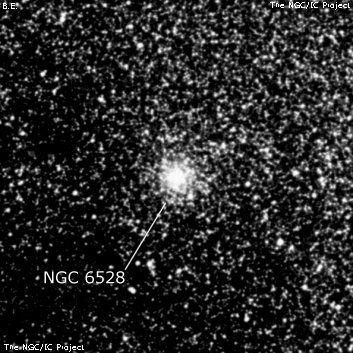
William Herschel discovered NGC 6528 = H II-200 = h3723, along with NGC 6522, on 24 Jun 1784 (sweep 232) and logged "F, pL, unequally bright, r." On 3 Aug 1834, JH recorded "globular cluster, B; R; R; glbM; resolved into stars 16m. Both this and I. 49 NGC 6522] occur on a ground so astonishing rich and stippled over with stars 17m individually discernible, as hardly to admit a pin's point between the stars, and this fills more than the whole field or many fields."
200/250mm - 8" (6/19/82): fairly faint, small, easily visible but no resolution.
300/350mm - 13.1" (6/29/84): fairly faint, small, 2' diameter, not resolved. This is a smaller and fainter version of globular cluster NGC 6522 15' W.
400/500mm - 17.5" (7/11/99): this is the smaller and fainter of an unusual double pair of globulars with NGC 6522 just 16' W. At 220x, it appears round, ~1.5' in diameter. The brightness gradually increased towards the center but there was no distinct core. The surface brightness was fairly smooth overall and the outer halo was fairly well defined. A mag 13.5 field star is at the SW edge. The surrounding field was noticeably more vacant than around NGC 6522. Both clusters can be placed at the edges of the 14' field of the 7mm Pentax XL. Situated within "Baade's Window" (absorption hole in the Milky Way).
Notes by Steve Gottlieb